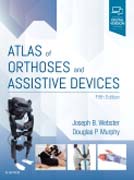
Advances in the material sciences, 3D printing technology, functional electrical stimulation, smart devices and apps, FES technology, sensors and microprocessor technologies, and more have lately transformed the field of orthotics, making the prescription of these devices more complex than ever before. Atlas of Orthoses and Assistive Devices, 5th Edition, brings you completely up to date with these changes, helping physiatrists, orthopaedic surgeons, prosthetists, orthotists, and other rehabilitative specialists work together to select the appropriate orthotic device for optimal results in every patient. INDICE: Section 1. Basics Section 1 Introduction 1. The Orthotic Prescription 2. Materials Science 3. Principles of Fabrication 4. Principles of Normal and Pathologic Gait Section 2. Spinal Orthoses Section 2 Introduction 5. Biomechanics of the Spine 6. Principles and Components of Spinal Orthoses 7. Orthoses for Spinal Pain 8. Orthoses for Spinal Deformities 9. Orthoses for Spinal Trauma and Postoperative Care 10. Orthoses for Osteoporosis Section 3. Upper Limb Orthoses Section 3 Introduction 11. Biomechanics of the Upper Limb 12. Principles and Components of Upper Limb Orthoses 13. Upper Limb Orthoses for the Stroke and Brain-Injured Patient 14. Upper limb Orthoses for Persons with Spinal Cord Injury and Brachial Plexus Injuries 15. Orthoses for the Burned Hand 16. Orthotic Considerations for Arthritis and Overuse Syndromes in the Upper Extremity 17. Functional Bracing of Selected Upper Limb Fractures Section 4. Lower Limb Orthoses Section 4 Introduction 18. Biomechanics of the Hip, Knee, and Ankle 19. Foot Biomechanics 20. Shoes and Shoe Modifications 21. Foot Orthoses 22. Lower Limb Orthoses 23. Lower Limb Orthoses for Persons with Spinal Cord Injury 24. Orthoses in Total Joint Arthroplasty 25. Knee Orthoses for Sports-Related Issues 26. Orthotic Management of Neuropathic and Dysvascular Feet 27. Orthotic Management of Polio and Postpolio Syndrome 28. Lower Limb Orthoses for Persons Who Have Had a Stroke 29. Assessment and Orthotic Management of Gait Dysfunction in Individuals with Traumatic Brain Injury Section 5. Pediatric Orthoses Section 5 Introduction 30. Congenital and Acquired Disorders 31. Pediatric Hip Orthoses 32. Orthoses for the Muscle Disease Patient 33. Orthoses for Cerebral Palsy 34. Orthoses for Myelomeningocele 35. Cranial Remolding Orthoses Section 6. Assistive Devices Section 6 Introduction 36. Canes, Crutches, and Walkers 37. Wheeled Mobility: Evaluation for Orthotic Seating and Positioning 38. Wheeled Mobility: Device Prescription and Care 39. Wheelchair and Assistive Device Considerations for Remote Settings 40. Communication Devices and Electronic Aids 41. Sports Adaptations and Assistive Devices for Recreation 42. Driving and Related Assistive Devices 43. Neuromuscular Stimulation 44. Exoskeletal Assisted Rehabilitation after Spinal Cord Injury 45. Future Trends and Research in Orthoses
- ISBN: 978-0-323-48323-0
- Editorial: Elsevier
- Encuadernacion: Cartoné
- Páginas: 664
- Fecha Publicación: 01/02/2018
- Nº Volúmenes: 1
- Idioma: Inglés
